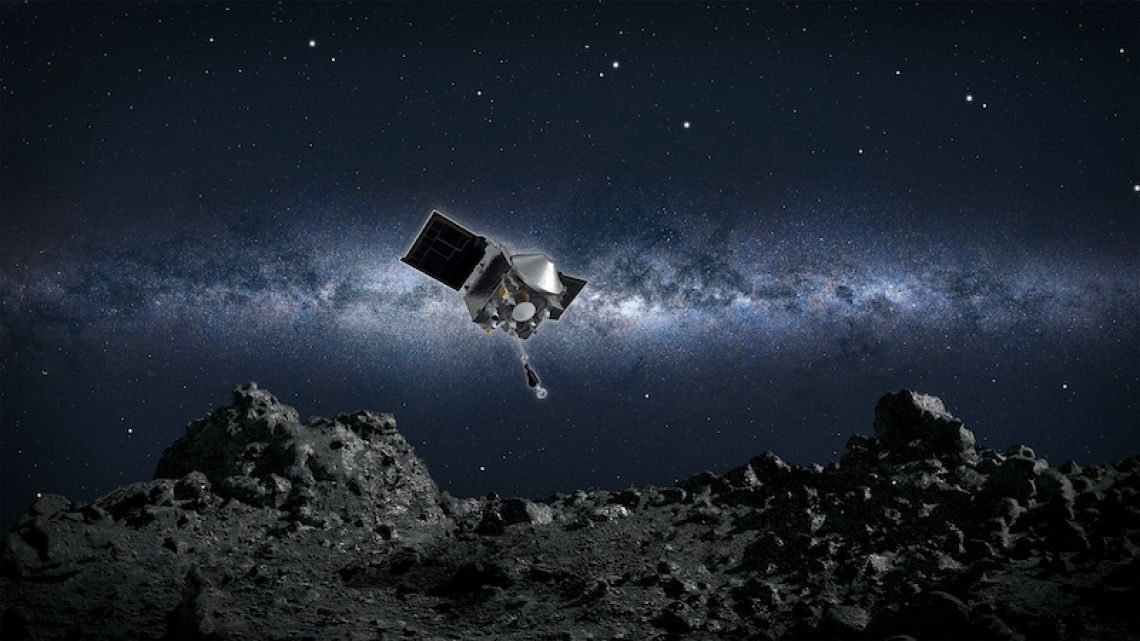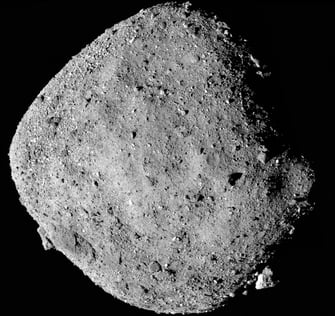OSIRIS-REx Delivers Largest-ever Asteroid Sample to Earth
Apex is proud to be onboard OSIRIS-REx, which has returned to earth after seven years with a gift from space.
Celebrating a legacy of contributing to diverse space endeavors, Apex Microtechnology is thrilled to share a remarkable milestone in space exploration. The recently concluded OSIRIS-REx mission achieved an unprecedented feat by becoming the first U.S. spacecraft to collect a sample from an asteroid and safely return it to Earth. On September 24th, 2023, the mission reached its culmination as the capsule touched down in the Utah desert, marking the triumphant completion of the OSIRIS-REx mission. Following the successful delivery, the spacecraft was coincidently renamed OSIRIS-APEX (OSIRIS-Apophis Explorer) and embarked on an extended mission to explore the asteroid Apophis, with a planned arrival in 2029. Apex Microtechnology takes pride in supplying components to OSIRIS-REx, now recognized as OSIRIS-APEX, contributing to the exploration of the wonders of outer space.
Apex's Radiation Tolerant Devices
We are thrilled to announce our highly anticipated radiation-tolerant product portfolio coming in 2024. After extensive research and development, Apex is proud to bring a range of devices to the space market designed for missions with challenging radiation environments. The Apex rad-tolerant product portfolio will launch in 2024 with five initial devices that have proven flight heritage and radiation data:
| Model |
Supply Voltage MAX (V) |
Output Current Continuous (peak) (A) | Slew Rate TYP (V/µs) | Quiescent Current max (mA) | Power Dissipation max (W) | Package |
| PA08R | 300 | 0.15 (0.2) | 30 | 8.5 | 17.5 | 8-pin TO-3 (CE) |
| PA07R | 100 | 5 | 5 | 30 | 67 | 8-pin TO-3 (CE) |
| PA12R | 100 | 10 (15) | 4 | 50 | 125 | 8-pin TO-3 (CE) |
| PA74R | 40 | 3 (x2 channels) | 1.4 | 40 | 36 per channel/60 total | 8-pin TO-3 (CE) |
| PA02R | 38 | 5 | 20 | 40 | 48 | 8-pin TO-3 (CE) |
Following the initial launch, Apex will continue to bring our cutting-edge technology to space. Our ongoing initiatives will include the expansion of our rad-tolerant portfolio, with future plans to introduce rad-tolerant variations of our silicon carbide integrated power modules.
Apex Microtechnology's radiation tolerant "R" grade devices are specifically built and tested to maintain operability after exposure to certain levels of radiation. Apex radiation tolerant devices include radiation characterization data for TID (HDR & ELDRS) and SEE as well as device TID lot traceability documentation and reporting.
For more information about Apex radiation tolerant "R" grade devices or for additional radiation testing options and capabilities offered by Apex, please fill out our Radiation Tolerant inquiry form.
OSIRIS-REx Mission Recap
As the third significant planetary science mission under NASA's New Frontiers Program, following New Horizons in 2006 and Juno in 2011, OSIRIS-REx (the Origins, Spectral Interpretation, Resource Identification, and Security-Regolith Explorer) aimed to deepen our understanding of the solar system's early formation and the origins of life on Earth. Developed by scientists at the University of Arizona, the mission also sought insights into asteroids with potential impact threats to Earth. The first goal of the spacecraft would be to collect a sample composed of rocks and dust from the surface of the asteroid 'Bennu' (formally 1999 RQ36) and return the sample back to Earth for further examination.
OSIRIS-REx spacecraft descends toward Bennu in this conceptual image. (Credit: NASA/Goddard/University of Arizona)
Launched from Cape Canaveral, Florida, on September 8, 2016, OSIRIS-REx, after separating from its Atlas V rocket, journeyed across the Moon's orbital path and eventually settled into orbit around the Sun. The spacecraft activated its scientific instruments on September 19, 2016, marking the beginning of the exploration.
Over the course of its mission, OSIRIS-REx was forced to execute various maneuvers, including trajectory correction, deep-space maneuvers, and gravity-assist encounters. Notably, on October 20, 2020, the spacecraft executed a historic "Touch-And-Go" (TAG) maneuver, unfurling its robotic arm to briefly touch down on the surface of Bennu at the "Nightingale" site, a northern crater with freshly exposed regolith, to collect the sample.
On April 7, 2021, OSIRIS-REx completed its final flyover of Bennu, capturing images for nearly 6 hours, covering a full rotation of the asteroid. Following this, on May 10, 2021, the spacecraft executed a crucial burn, propelling it away from Bennu at speeds of 600 miles per hour. OSIRIS-REx would set out on a 2.5-year cruise back to Earth to return the coveted sample.
Bennu: composed of 12 PolyCam images collected on December 2nd, 2018 by the OSIRIS-REx spacecraft from 15 miles away. (Credit: NASA/Goddard/University of Arizona)
OSIRIS-REx Achieves Historic Milestone
After two orbits around the sun, OSIRIS-REx reached Earth on September 24th, 2023. The capsule, carrying fragments of Bennu, detached from the main spacecraft and descended into Earth's atmosphere. Parachuting down, it landed at the Department of Defense's Utah Test and Training Range where the OSIRIS-REx team was eager to retrieve it. The sample - which is estimated to be 8.8 ounces - was transported to NASA's Johnson Space Center in Houston, Texas. Upon opening the canister, a delightful surprise awaited: 1.5 grams of bonus material adorned the exterior of the collector head and main sample canister.
Outside of the OSIRIS-REx sample canister. The extra sample material can be seen on the right with the bulk of sample material located inside. (Credit: NASA/Erika Blumenfeld and Joseph Aebersold)
Preliminary studies of the 4.5-billion-year-old sample revealed evidence of significant carbon content and water. This particular combination suggests that the rock may harbor the foundational elements necessary for life on Earth. While additional research is required to understand the characteristics of the discovered carbon compounds, the initial findings hold promise for subsequent analysis of the asteroid sample. The OSIRIS-REx team, along with scientists globally, are eagerly anticipating the opening of the main canister to commence research on the long-awaited sample. The contents of the main canister offer valuable insights into the formation of our solar system, the potential seeding of precursor materials for life on Earth, and the precautions required to prevent asteroid collisions with our home planet.
Within the framework of OSIRIS-REx's scientific initiative, a global assembly of over 200 scientists, including researchers from various U.S. institutions, collaborators from NASA partners such as JAXA (Japan Aerospace Exploration Agency) and CSA (Canadian Space Agency), as well as scientists worldwide, will research into the properties of the sample. Furthermore, supplementary samples will be loaned to the Smithsonian Institution, Space Center Houston, and the University of Arizona for public exhibition at a future date. To learn more about the OSIRIS-REx mission click here.
OSIRIS-APEX Mission Overview
The mission concluded its primary objective with the safe retrieval of the asteroid sample. However, the OSIRIS-REx spacecraft did not rest; instead, it set its eyes on Apophis, a near-Earth asteroid estimated to be 1,200 feet in diameter. The mission coincidentally named OSIRIS-APEX (OSIRIS-Apophis Explorer) will explore the physical changes of Apophis after its upcoming rare close encounter with Earth. In 2029, Apophis' orbit will bring it within 20,000 miles of Earth's surface, which is closer than any of our highest-altitude satellites. The gravitational pull from Earth is predicted to alter the asteroid's orbit, affecting the rotational dynamics and potentially cause quakes or landslides that would alter the surface of the asteroid. OSIRIS-APEX enables scientists a peek into the composition of the material below the asteroid's surface by utilizing its thrusters to stir up debris on the surface of Apophis. View the full details of the OSIRIS-APEX mission here.
OSIRIS-APEX will use its thrusters to stir up rocks and dust on the surface of Apophis to enable scientists to study the material below. (Credit: NASA's Goddard Space Flight Center Conceptual Image Lab)
Apex's Contribution to OSIRIS-REx
Apex is honored to have supplied our high-performance operational amplifier, PA12, to this groundbreaking mission in space exploration. We take pride in being onboard OSIRIS-REx and we look forward to witnessing the incredible scientific discoveries that emerge from this historic mission.
The PA12 is a state-of-the-art high voltage (±50V), very high output current (±15A PEAK) operational amplifier designed to drive resistive, inductive and capacitive loads. This hybrid integrated circuit utilizes thick film (cermet) resistors, ceramic capacitors and semiconductor chips to maximize reliability, minimize size and give top performance. Ultrasonically bonded aluminum wires provide reliable interconnections at all operating temperatures. The PA12 is in a hermetically sealed and electrically isolated 8-pin TO-3 package and available in standard, "M", "M/883", and soon to be radiation tolerant (R) grade variants.
PA12 Key Specifications-1.png?width=315&height=212&name=MicrosoftTeams-image%20(122)-1.png)
- Voltage supply operation - ±10V to ±45V
- High output current - up to 15A PEAK
- Low thermal resistance – 1.4°C/W
- Current fold over protection
- Excellent linearity - Class A/B output
- SMD #: 5962-9065901HXA
Congratulations to everyone involved in the OSIRIS-REx mission and here's to the continued success of OSIRIS-APEX and the endless possibilities that lie ahead. See you in space!
- Apex Microtechnology
.png)


-2.png?width=2000&height=995&name=MicrosoftTeams-image%20(119)-2.png)
%20(1).png?width=1902&height=986&name=MicrosoftTeams-image%20(121)%20(1).png)